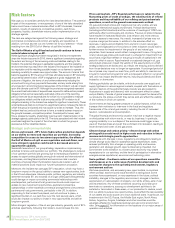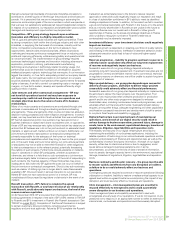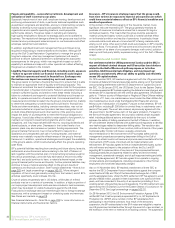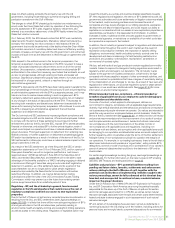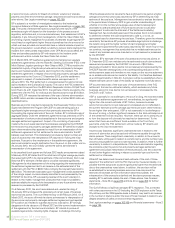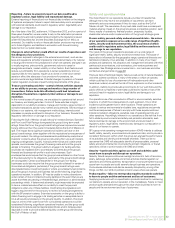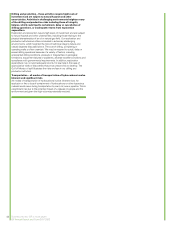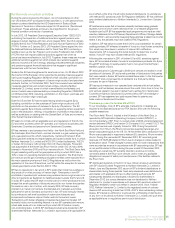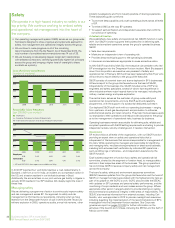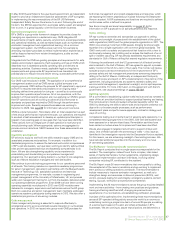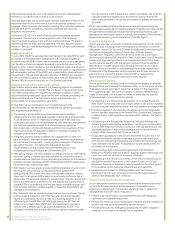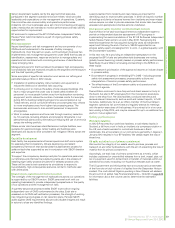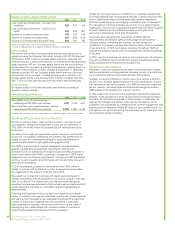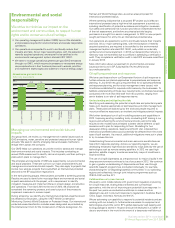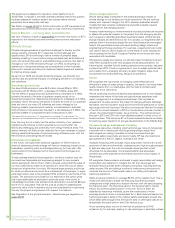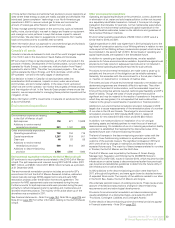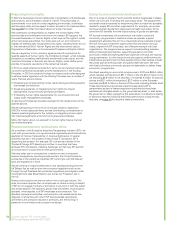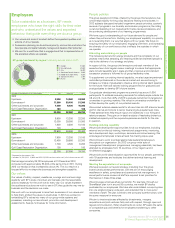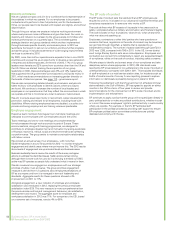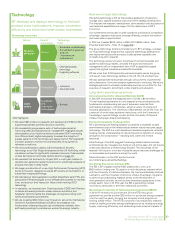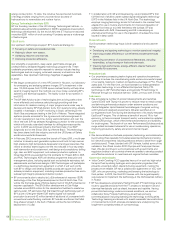BP 2012 Annual Report Download - page 50
Download and view the complete annual report
Please find page 50 of the 2012 BP annual report below. You can navigate through the pages in the report by either clicking on the pages listed below, or by using the keyword search tool below to find specific information within the annual report.
Business review: BP in more depth
BP Annual Report and Form 20-F 2012
48
high standard across all of our well operations, and are independently
verified by our S&OR audit or internal audit function.
We have estimated and communicated delivery timelines for each of the
recommendations and will continue to provide periodic updates of our
progress. These timelines are based on existing facts and circumstances
and can shift due to complexity, resource availability and evolving
regulatory requirements.
At the end of 2012, 14 of the Bly Report recommendations had been
completed. We continue to make progress on all of the remaining
recommendations largely in line with our planned schedule. Progress is
tracked quarterly by executive management. We also regularly update
investors. See bp.com/internalinvestigation for the full report and periodic
updates on progress.
Independent advice
In June 2012 the BP board appointed Carl Sandlin to provide SEEAC with
an objective and independent assessment of BP’s global progress in
implementing the 26 Bly Report recommendations and on process safety.
Carl Sandlin will also on occasion be asked to provide his views to the
board on other matters related to, but not specifically within the scope of
the Bly Report recommendations, for example, his views on organizational
effectiveness or culture of the GWO and process safety observations in
the upstream. He has direct access to the chair of SEEAC and will report
to the committee in person at least twice a year. See BP Sustainability
Review 2012 for more information on Carl Sandlin’s activities.
Delivering enhanced processes and practices
Eight interim actions were issued to our operating regions immediately
following the publication of the Bly Report. Seven of those actions have
now been incorporated into engineering technical practices or other
documents being developed as part of the work towards completing the
26 recommendations. The final interim action is scheduled to be
incorporated into a new practice in early 2013.
During 2012, as we continued to work towards delivering the
recommendations, we developed or refreshed key operating practices
and engineering standards on:
t Cementing or zonal isolation: we have issued new mandatory
requirements and nine associated guides covering cementing activities.
As of December 2012, 711 technical professionals in BP have now
undergone training on the revised practices. We have also strengthened
the technical approval process for some cementing operations.
Systematic input into the well design workflow now requires both the
regional and global BP specialist to agree on the basis of design for
complex zonal isolation activities.
t Integrating process safety concepts into management of wells: we
have produced a technical practice specifying minimum requirements
for well barrier management – managing the movement of fluids and
gas within the well – throughout the life cycle of the well.
Implementation of this practice has commenced with two-day
workshops training 624 people as of December 2012.
t Well casing design: we have updated our design manual for well casing
and inner tubing to include new requirements for pressure tests and
revised technical practices. A one-day training workshop on this revised
practice has been developed for BP professionals and 247 people have
been trained as of December 2012.
t BOP stacks: we have issued a revised technical practice on well control,
defining and documenting our requirements for subsea BOP
configurations. We require two sets of blind shear rams and a casing
shear ram for all subsea BOPs used on dynamically positioned rigs in
deep water. This exceeds regulatory requirements. We also require that
third-party verification is carried out on the testing and maintenance of
subsea BOPs in accordance with industry recommended practice, and
that remotely operated vehicles capable of operating these BOPs are
available in an emergency.
t Rig intake and start-up operating procedure: we have continued the rig
audit process enhanced in 2011. We have also conducted detailed
hazard and operability reviews for key fluid handling systems on all
offshore rigs in the BP fleet. All drilling rigs joining the BP fleet are
subject to an independent S&OR audit and readiness to operate is
verified with a detailed go/no-go process assured by S&OR. This
includes a checklist that, among other things, assists in assessing that
the rig conforms to BP practices and industry standards, that it has the
necessary technical specification, and that the actions required for
start-up are completed. All rigs are also subject to subsequent periodic
rig audits.
BP is in the process of issuing the above guides and implementing the
above practices across all our operating regions. Practices are implemented
through training workshops and accompanying training materials, gap
assessments, and requirements for reaching conformance. We continue to
progress the remaining recommendations of the Bly Report.
External investigations
There have also been a number of external investigations into the Gulf of
Mexico oil spill, including those of the National Commission on the BP
Deepwater Horizon Oil Spill and Offshore Drilling (oilspillcommission.gov)
and the joint investigation team of the Bureau of Ocean Energy
Management, Regulation and Enforcement and the US Coast Guard
(boemre.gov/ooc/press/2011/press0914.htm). Additionally, the US National
Academy of Engineering undertook an independent study. All of these
reports were consistent with the general conclusion that the accident
resulted from multiple causes and was due to the actions of multiple
parties. We are committed to understanding the causes, impacts and
implications of the Deepwater Horizon incident and to learn and act on
lessons from it. As part of this commitment, BP is reviewing the
recommendations from government and industry reports.
Sharing lessons learned
We are committed to sharing what we have learned globally to advance
the capabilities and practices that enhance safety in our company and the
deepwater industry and help to prevent an accident of this magnitude
from happening again. We have conducted more than 200 briefings in
nearly 30 countries over the past two years to share lessons learned.
Other examples of our collaboration include:
t Participating in the International Association of Oil & Gas Producers’
Well Expert Committee that is working to prevent well control incidents
by improving well engineering design and well operations management.
t Providing equipment and expertise developed during the Deepwater
Horizon accident response to the Marine Well Containment Company
to help industry meet regulatory requirements for drilling in the Gulf of
Mexico.
t Participating in the Subsea Well Response Project to enhance the
industry’s global well capping capabilities – resulting in a collaboration
with Oil Spill Response Limited to build four well cap systems and two
dispersant application equipment packages due to be positioned in
Europe, Africa, Asia and South America in 2013.
t Filing patent applications in the US and elsewhere to cover about 30
technical innovations related to well capping and containment work,
with the aim of ensuring the capping and containment technology we
have developed will be open for access and further development for
the benefit of the industry.
t Implementing a technology licence agreement with Petróleos
Mexicanos (PEMEX) that will share BP capping system technology and
know-how with the national oil company of Mexico.
t Participating in the 19 sub-committees of the IPIECA/International Oil
and Gas Producers Association, Joint Industry Project on Oil Spill
Response, focused on developing recommendations for effective and
fit-for-purpose oil spill response preparedness and capability.
t Establishing the Center for Offshore Safety with the American
Petroleum Institute with a mission to promote the highest level of
safety in the deepwater Gulf of Mexico.
Safety in the Downstream business
In our hydrocarbon facilities across the Downstream business we focus
on the safe storage, handling and processing of hydrocarbons via
systematic management of associated operating risks. In seeking to
manage these risks, BP takes measures to:
t Prevent loss of hydrocarbon containment through well-designed,
maintained and operated equipment.
t Reduce the likelihood of any hydrocarbon releases and the possibility of
ignition that may occur by controlling ignition sources.
t Provide safe locations, emergency procedures and other mitigation
measures in the event of a release, fire or explosion.


